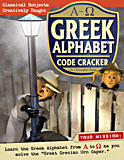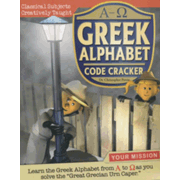If you’ve been considering teaching Greek to your children or even learning it yourself, you might want to start with Greek Alphabet Code Cracker. Learning Greek begins with learning to recognize the Greek alphabet and the sounds of the letters. This 91-page book accomplishes that and a bit more, and it does so in an entertaining fashion that should appeal to learners of all ages.
Great graphic design combines with fun activities to make learning more like puzzle solving than real work. The book begins by introducing the case of the missing urn. The student’s task is to decipher clues to determine the identity of the thief and recover the urn. This is accomplished by translating a few Greek words within each witness’s statement that will provide the clues. In addition to solving the crime, students work on puzzles and worksheet type activities—word searches, matching columns, code-breaking puzzles, crossword puzzles, circling words, filling in blanks, and more. Students practice tracing then writing letters of the Greek alphabet and complete a number of more direct translation activities. Instruction is presented incrementally through the units. The eight units in this book should take about eight weeks to complete, but you can adjust the pace as you wish.
By the end of the book, students should be fairly proficient at translating Greek letters into their corresponding English letters, and they will also have learned something about breathing and accent marks. They will also have learned 25 NT/Koine words.
The publisher’s website has a password-protected audio file of the “Greek Alphabet Song” you can listen to at no cost as well as three other songs that teach the names and sounds of the letters, consonant blends, and diphthongs. Also on the site are Greek alphabet writing-practice sheets, a reference chart, alphabet flash cards, and a code-cracker master sheet. Printing out the reference sheet and keeping it handy saves students having to flip pages in the book as they work. A few code-cracker activities are included in the book, but students might well like to do more with the master sheet.
Toward the back of the book are two pages to make a “Greek Alphabet Code Cracker Cypher Wheel” that might also serve as a handy reference tool. A complete answer key is included at the back.
Once students have completed this book, there’s a good chance they will be eager to continue studying the Greek language. But even if they do not continue, what they will have learned here will be helpful as they encounter references to letters of the Greek alphabet in other contexts.










